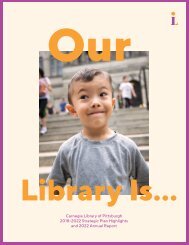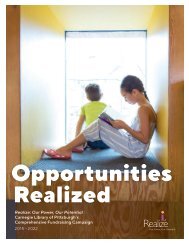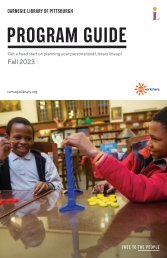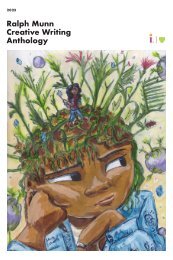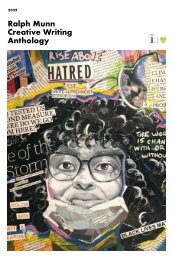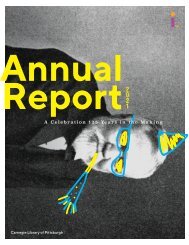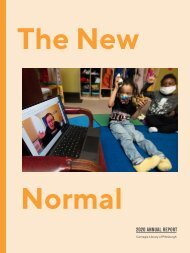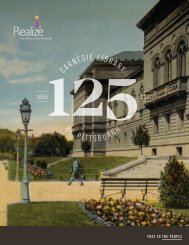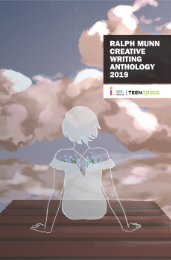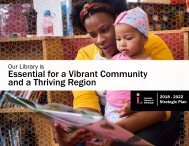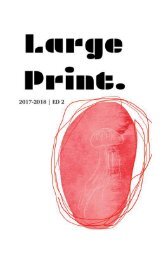Carnegie Library of Pittsburgh Strategic Plan 2018 - 2022 - Appendix
Create successful ePaper yourself
Turn your PDF publications into a flip-book with our unique Google optimized e-Paper software.
INCLUSIVE &<br />
EQUITABLE<br />
RESPONSIVE &<br />
ADAPTABLE<br />
INFORMATIVE &<br />
EMPOWERING<br />
<strong>2018</strong>-<strong>2022</strong><br />
STRATEGIC<br />
PLAN<br />
WELCOMING<br />
& VIBRANT<br />
INSTRUCTIVE &<br />
ENLIGHTENING<br />
COLLABORATIVE<br />
& INNOVATIVE<br />
APPENDIX
THE PROCESS<br />
CALENDAR<br />
Consultation with library Board, staff at all levels and<br />
community and other stakeholders has been an integral<br />
part <strong>of</strong> this year-long strategic planning process.<br />
Part 1: January – March 2017<br />
Kick-Off and Preliminary <strong>Plan</strong>ning<br />
In January, library managers and staff identified trends, big<br />
shifts or quiet evolutions occurring in the library pr<strong>of</strong>ession, our<br />
community and our world that should inform the plan and evaluate<br />
how these might impact the <strong>Library</strong> and our work over the next five<br />
years. With several themes emerging from the feedback gathered,<br />
staff workgroups were convened in March around the five goal<br />
areas from the previous plan: Within the <strong>Library</strong> Walls; <strong>Library</strong><br />
in Your Neighborhood, Community & Schools; <strong>Library</strong> in a<br />
Changing World <strong>of</strong> Information; <strong>Library</strong> Funding & Contributions;<br />
and Measuring and Sharing the <strong>Library</strong>’s Impact. These workgroups<br />
reviewed accomplishments in these areas over the past<br />
five years, and each group proposed ten actions and indicators for<br />
success for the next five years. Staff reconvened in late March to<br />
review 50 ideas generated by the workgroups to select ideas to<br />
test with the community.<br />
Part 2: April – June 2017<br />
Community Engagement<br />
Part 2 focused on soliciting feedback from various stakeholders,<br />
including library users, Board members, community partners,<br />
county libraries, donors, and the general public. Input was<br />
gathered within our libraries, through our website, at various<br />
community events as well as through formal meetings.<br />
Over a period <strong>of</strong> six weeks, the <strong>Library</strong> posed a series <strong>of</strong><br />
aspirational questions that everyone was invited to respond to:<br />
April 24 – May 6:<br />
“In 5 years, I hope <strong>Pittsburgh</strong>…” and<br />
“In 5 years, I hope that I…”<br />
May 7 – May 20:<br />
“The <strong>Library</strong> is important to my community because…” and<br />
“The <strong>Library</strong> is important to me because…”<br />
May 21 – June 4:<br />
“The <strong>Library</strong> <strong>of</strong> the future should…”<br />
Close to 2,000 responses were received that helped<br />
inspire the plan.<br />
Two input sessions with the <strong>Library</strong>’s community partners<br />
convened over 60 people representing nearly 50 different<br />
organizations. A third session was held with representatives<br />
from over 20 county libraries. Participants were asked to share<br />
what they would like CLP to know about their work and the people<br />
they serve and how <strong>Carnegie</strong> <strong>Library</strong> <strong>of</strong> <strong>Pittsburgh</strong> supports that<br />
work. Several sessions also were held with library donors to get<br />
perspective on why they feel the <strong>Library</strong> is important to the<br />
community, what might be done to improve library service and<br />
why they feel compelled to support the <strong>Library</strong>.<br />
In late June, a series <strong>of</strong> meetings was held with CLP’s Board<br />
<strong>of</strong> Trustees to share highlights from the community feedback,<br />
discuss emerging ideas and review identified priorities for the<br />
<strong>Library</strong> and the Board over the next five years.<br />
Part 3: July – August 2017<br />
Internal Review & Refinement<br />
During the summer, staff and Board reviewed and refined<br />
emerging ideas and strategies. Elements <strong>of</strong> the plan were<br />
placed in the context <strong>of</strong> the type <strong>of</strong> library experience users<br />
can expect to have, how the community will benefit, and how<br />
staff, Board and volunteers will contribute to the success <strong>of</strong><br />
each strategic priority. Staff helped define what success might<br />
look like in terms <strong>of</strong> how both the <strong>Library</strong> and our community<br />
would be different at the end <strong>of</strong> five years. Staff also provided<br />
input on the tools and support they might need in helping to<br />
achieve success.<br />
Additional information was compiled to cite specific data that<br />
CLP routinely reviews and utilizes to inform and validate the plan.<br />
Best practices from other libraries, community demographics,<br />
trends in the pr<strong>of</strong>ession and trends in the community have been<br />
documented as part <strong>of</strong> this plan.<br />
Part 4: September – December 2017<br />
In the fall, strategic areas <strong>of</strong> focus were finalized and<br />
specific actions were developed for each area along with<br />
indicators <strong>of</strong> success and relevant statistics, measures and<br />
stories that will help measure progress. A draft plan was<br />
presented to CLP’s Board <strong>of</strong> Trustees for discussion at a<br />
Board Retreat in October. Staff reviewed the final plan in<br />
November, and the Board approved the plan at its December<br />
meeting. The Allegheny Regional Asset District Board will review<br />
the <strong>Library</strong>’s strategic plan for approval in early <strong>2018</strong>.<br />
Board <strong>Strategic</strong> <strong>Plan</strong>ning Committee Meetings<br />
January 31, April 6, May 12, July 13, September 7,<br />
October 5, November 10<br />
Staff Input Sessions #1 – January 24, 25, 26<br />
Staff Special Workgroups – Month <strong>of</strong> March<br />
Staff Input Sessions #2 – March 27, 29, 30<br />
Quarterly Managers Meeting<br />
March 29, July 12, October 18, December 6<br />
Community Partner Meetings – June 7, 9<br />
District Advisory Council/County Libraries – June 22<br />
Board <strong>of</strong> Trustees <strong>Strategic</strong> <strong>Plan</strong>ning Sessions<br />
June 28, 29, and July 6<br />
Donor Leadership Briefings – July 12, 19, 20, 25, 26<br />
Staff Input Sessions #3 – August 15, 16, 23<br />
Board Retreat – October 16<br />
Staff Input Sessions #4 – November 13, 15, 16<br />
Board Approval – December 11<br />
RAD Board Approval – 1st quarter <strong>2018</strong><br />
A Note about <strong>Carnegie</strong> <strong>Library</strong> <strong>of</strong> <strong>Pittsburgh</strong>’s<br />
125th Anniversary<br />
<strong>Carnegie</strong> <strong>Library</strong> <strong>of</strong> <strong>Pittsburgh</strong> will celebrate 125 years in<br />
2020. Many good ideas were generated when people were<br />
asked how the <strong>Library</strong> might commemorate this special<br />
occasion. If you have a good idea that you would like to<br />
submit, please contact info@carnegielibrary.org.
ACKNOWLEDGEMENTS<br />
<strong>Carnegie</strong> <strong>Library</strong> <strong>of</strong> <strong>Pittsburgh</strong> wishes to thank the hundreds<br />
<strong>of</strong> people who contributed to the development <strong>of</strong> this plan.<br />
Community stakeholders, residents, staff, Board, library users,<br />
county libraries and donors have all provided significant input.<br />
We extend a special thank you to the groups named below for<br />
their leadership.<br />
BOARD STRATEGIC<br />
PLANNING COMMITTEE<br />
Greg Zovko, Chair<br />
Bruce Kraus<br />
Matt Mohn<br />
Diane Powell<br />
Carol Robinson, Board Chair<br />
LaShawnda Thomas<br />
STAFF STRATEGIC PLAN<br />
STEERING COMMITTEE<br />
Mary Frances Cooper,<br />
President & Director<br />
Sue Banks<br />
Molly Bennett<br />
Toby Greenwalt<br />
Holly McCullough<br />
Mary Monaghan<br />
Karlyn Voss<br />
STRATEGIC PLAN<br />
STAFF WORKGROUPS<br />
Within the <strong>Library</strong> Walls:<br />
Steven Banks<br />
Jody Bell<br />
Amy Ergler<br />
Chris Gmiter<br />
Marta Honores<br />
Anne Lee<br />
Bonnie McCloskey<br />
Karen Meharra<br />
Tammy Stoken<br />
Carlton Stout<br />
Matthew Thomas<br />
Pat Winter<br />
The <strong>Library</strong> in<br />
Your Neighborhood,<br />
Community & Schools:<br />
Kristen Abels<br />
Jason Bard<br />
Don Ciccone<br />
Katy Critchfield<br />
Amy Dwyer<br />
Melissa Firman<br />
Abby Harwood<br />
Susan Hudak<br />
Jane Jessell<br />
Kathy Maron-Wood<br />
Scott Meneely<br />
Caitie Morphew<br />
Alicia Pelfrey<br />
Renee Robinson<br />
Erin Scioli<br />
Jess Smith<br />
Maria Taylor<br />
Eleanor Tutt<br />
Bonny Yeager<br />
Irene Yelovich<br />
Lauren Zabelsky<br />
Whitney Zernich<br />
The <strong>Library</strong> in a<br />
Changing World <strong>of</strong> Information:<br />
Holly Anderton<br />
LeeAnn Anna<br />
Thomas Barnes<br />
Kira Condee-Padunova<br />
Henry Dragenflo<br />
Denise Graham<br />
Dan Hensley<br />
Schuyler Hernstrom<br />
Maria Joseph<br />
Richard Kaplan<br />
Joelle Killebrew<br />
Tina LaMark<br />
Cathy Lamoureaux<br />
Hilary Lewis Lackner<br />
Laura Perrier<br />
Mary Phillips<br />
Debbie Priore<br />
Brooke Sansosti<br />
Gino Stinelli<br />
Funding & Contributions:<br />
Tessa Barber<br />
Virginia Beck<br />
Georgia Dawson<br />
Joanne Dunmyre<br />
Leah Durand<br />
Ian Eberhardt<br />
Leigh Anne Focareta<br />
Deanne Heller<br />
Rick Hertzig<br />
David King<br />
Julianna Kuchta<br />
Mark Lee<br />
Rachel Masilamani<br />
Measuring and Sharing<br />
the <strong>Library</strong>’s Impact:<br />
Jon Antoszewski<br />
Lisa Boyd<br />
Kelsea Collins<br />
Devon Evans<br />
Julie Hanify<br />
Barb Lawler<br />
Abbey Lukiewski<br />
Melissa McKenna<br />
Emily Miller<br />
Julianne Moore<br />
Mary Beth Parks<br />
Shayna Ross<br />
Courtney St<strong>of</strong>ko<br />
Marian Streiff<br />
Tess Wilson<br />
Sherry Yadlosky<br />
We also want to thank<br />
the numerous Community<br />
Organizations that<br />
provided valuable input:<br />
1Hood Media<br />
Allegheny Conference<br />
on Community Development<br />
Allegheny County - Department<br />
<strong>of</strong> Human Services<br />
Allies for Children<br />
assemble<br />
The Brashear Association<br />
<strong>Carnegie</strong> Museums<br />
<strong>of</strong> <strong>Pittsburgh</strong><br />
<strong>Carnegie</strong> Science Center<br />
Center for Civic Leadership<br />
Children’s Museum <strong>of</strong><br />
<strong>Pittsburgh</strong><br />
City <strong>of</strong> <strong>Pittsburgh</strong> - Bureau <strong>of</strong><br />
Neighborhood Empowerment<br />
City <strong>of</strong> <strong>Pittsburgh</strong> - Office <strong>of</strong><br />
Sustainability & Resilience<br />
City Theatre<br />
Community Human Services<br />
Coro/Public Allies<br />
Greater <strong>Pittsburgh</strong> Arts Council<br />
Greater <strong>Pittsburgh</strong> Literacy<br />
Council<br />
Heinz History Center<br />
Hill House Association & Hill<br />
House Economic Development<br />
Corporation<br />
Housing Authority <strong>of</strong> the<br />
City <strong>of</strong> <strong>Pittsburgh</strong><br />
Lawrenceville United<br />
Neighborhood Allies<br />
Neighborhood Learning Alliance<br />
Office <strong>of</strong> State Senator<br />
Wayne Fontana<br />
PA CareerLink ®<br />
<strong>Pittsburgh</strong>/Allegheny County<br />
<strong>Pittsburgh</strong> Arts & Lectures<br />
<strong>Pittsburgh</strong> Cultural Trust<br />
<strong>Pittsburgh</strong> Downtown<br />
Partnership<br />
<strong>Pittsburgh</strong> Filmmakers/<br />
<strong>Pittsburgh</strong> Center for the Arts<br />
<strong>Pittsburgh</strong> Promise<br />
<strong>Pittsburgh</strong> Public Schools<br />
<strong>Pittsburgh</strong> Zoo & PPG Aquarium<br />
Port Authority <strong>of</strong><br />
Allegheny County<br />
Public Source<br />
Reading Is FUNdamental<br />
<strong>Pittsburgh</strong><br />
Remake Learning Network<br />
Shuman Juvenile<br />
Detention Center<br />
Sprout<br />
Squirrel Hill Urban Coalition<br />
United Way <strong>of</strong> Southwestern<br />
Pennsylvania<br />
University <strong>of</strong> <strong>Pittsburgh</strong><br />
Archives Service Center<br />
University <strong>of</strong> <strong>Pittsburgh</strong>, School<br />
<strong>of</strong> Computing and Information<br />
Vibrant <strong>Pittsburgh</strong><br />
Western Pennsylvania<br />
Regional Data Center<br />
WQED Education Department<br />
WYEP/WESA<br />
YWCA<br />
We are grateful to the<br />
following Allegheny County<br />
libraries for their participation<br />
in this process:<br />
Allegheny County<br />
<strong>Library</strong> Association<br />
Andrew Bayne Memorial <strong>Library</strong><br />
Avalon Public <strong>Library</strong><br />
Bethel Park Public <strong>Library</strong><br />
<strong>Carnegie</strong> <strong>Library</strong> <strong>of</strong> Homestead<br />
Clairton Public <strong>Library</strong><br />
Crafton Public <strong>Library</strong><br />
Monroeville Public <strong>Library</strong><br />
Moon Township Public <strong>Library</strong><br />
Mt. Lebanon Public <strong>Library</strong><br />
Northland Public <strong>Library</strong><br />
North Versailles Public <strong>Library</strong><br />
Oakmont <strong>Carnegie</strong> <strong>Library</strong><br />
Robinson Township <strong>Library</strong><br />
Scott Township Public <strong>Library</strong><br />
Shaler North Hills <strong>Library</strong><br />
South Park Township <strong>Library</strong><br />
Western Allegheny<br />
Community <strong>Library</strong><br />
Wilkinsburg Public <strong>Library</strong><br />
eiNetwork
DATA AND CONTEXT RESOURCES<br />
EQUITY & INCLUSION<br />
Association <strong>of</strong> College & Research Libraries - Diversity<br />
Standards: Cultural Competency for Academic Libraries (2012)<br />
Center on Race and Social Problems, University <strong>of</strong> <strong>Pittsburgh</strong><br />
Inequities Affecting Black Girls in <strong>Pittsburgh</strong> and<br />
Allegheny County<br />
University <strong>of</strong> <strong>Pittsburgh</strong>’s School <strong>of</strong> Education,<br />
Center for Urban Education<br />
Kalamazoo College, Arcus Center for Social Justice Leadership<br />
Association for Specialized and Cooperative <strong>Library</strong> Agencies<br />
LIBRARY SERVICES – TRENDS AND BEST PRACTICES<br />
American <strong>Library</strong> Association<br />
American <strong>Library</strong> Association’s Center for the Future <strong>of</strong><br />
Libraries, <strong>Library</strong> <strong>of</strong> the Future: Trends<br />
American Libraries Magazine<br />
Aspen Institute, Communications & Society/Libraries<br />
2017 Next <strong>Library</strong> Conference in Aarhus, Denmark<br />
<strong>Library</strong> Journal<br />
Public <strong>Library</strong> Association<br />
Urban Libraries Council<br />
Pew Research Center<br />
Research Institute for Public Libraries<br />
NATIONAL, STATE AND LOCAL LIBRARY STATISTICS<br />
FOR BENCHMARKING<br />
Public <strong>Library</strong> Association (PLDS)<br />
IMLS Public <strong>Library</strong> Data<br />
PA <strong>Library</strong> Statistics<br />
ACLA Wiki<br />
eiNetwork Intranet<br />
REGIONAL DATA<br />
<strong>Pittsburgh</strong> Today: Key Indicators for Understanding Our Region<br />
Pubic Source – Compiled data resources<br />
Western Pennsylvania Regional Data Center<br />
2010 Census specific to Pittsbugh<br />
TECHNOLOGY<br />
Digital Public <strong>Library</strong> <strong>of</strong> America<br />
Pew Research Center - Internet and Technology<br />
<strong>Pittsburgh</strong> Technology Council, The Creative Industries Network<br />
Edge <strong>Library</strong> Technology Assessment<br />
Tech Trends for 2017<br />
YOUTH SERVICES<br />
Child Trends<br />
National Association for the Education <strong>of</strong> Young Children<br />
National Center for Families Learning<br />
University <strong>of</strong> <strong>Pittsburgh</strong> Office <strong>of</strong> Child Development<br />
YOUmedia Learning Labs Network<br />
Harvard Graduate School <strong>of</strong> Education – Project Zero<br />
Young Adult <strong>Library</strong> Services Association<br />
Association for <strong>Library</strong> Service to Children<br />
Remake Learning<br />
Mentoring Partnership<br />
Annie E. Casey Foundation – Kids Count<br />
Family and Youth Services Bureau –<br />
National Clearinghouse on Families & Youth<br />
The <strong>Pittsburgh</strong> Foundation, “A Qualitative Study <strong>of</strong> Youth<br />
and the Juvenile Justice System”<br />
Harvard Family Research Project, Harvard Graduate<br />
School <strong>of</strong> Education<br />
Zero to Three<br />
Family Place Libraries<br />
Erikson Institute<br />
Fred Rogers Center<br />
American Academy <strong>of</strong> Pediatrics<br />
WORKFORCE DEVELOPMENT<br />
Allegheny Conference, “Inflection Point: Supply, Demand and<br />
the Future <strong>of</strong> Work in the <strong>Pittsburgh</strong> Region (2016)<br />
Corporation for National & Community Service<br />
COMMUNITY AND ENVIRONMENTAL SCANNING:<br />
Community Scanning:<br />
Literate Cities<br />
New York Times Mapping America<br />
New York Times Mapping Poverty<br />
Pew Reports - Environmental Scanning:<br />
7 Things to Know About Offline Americans<br />
The Internet <strong>of</strong> Things and What It Means For Librarians<br />
Americans Feel Better Informed Thanks to the Internet<br />
What Will Digital Life Look Like in 2025?<br />
Younger Americans’ <strong>Library</strong> Habits and Expectations<br />
Pennsylvania Early Learning Keys to Quality
KEY INDICATORS<br />
1. The city as a whole is getting younger, but the overall<br />
population is still shrinking. <strong>Pittsburgh</strong> as a city has flat<br />
population growth in the past few years. The city as a whole<br />
reported a net loss <strong>of</strong> 239 residents from 2015 to 2016. Efforts<br />
by the region and the Mayor’s <strong>of</strong>fice to create a welcoming<br />
environment for new residents and immigrants are creating<br />
positive gains. American Community Survey data from 2015<br />
shows growth in both the 25-29 (10.8%) and 30-34 (7.9%)<br />
age groups, outpacing both regional and national benchmarks.<br />
Likewise, over 4000 foreign-born moved to the region in 2015 –<br />
the largest gain in 10 years. However, foreign-born residents <strong>of</strong><br />
<strong>Pittsburgh</strong> make up 8.2% <strong>of</strong> its total population, compared to a<br />
level <strong>of</strong> 13.2% for the United States according to the 2011-2015<br />
American Community Survey.<br />
However, this modest influx <strong>of</strong> new residents and immigrants is<br />
counteracted by a rapidly aging base population. The <strong>Pittsburgh</strong><br />
Metropolitan Service Area (which extends beyond Allegheny<br />
County) is home to one <strong>of</strong> the country’s largest concentrations <strong>of</strong><br />
people age 65 and older – 18.7% <strong>of</strong> the overall 2015 population<br />
according to <strong>Pittsburgh</strong> Today. This can present a number <strong>of</strong><br />
issues that warrant <strong>Library</strong> attention – from quality <strong>of</strong> life to job<br />
training to geriatric health services.<br />
2. Ethnic demographics are shifting – but not by much. The<br />
<strong>Pittsburgh</strong> region still has a predominantly white population –<br />
roughly 65% as <strong>of</strong> 2014. The region has seen significant gains<br />
in Latino and Asian/Pacific Islander populations, with respective<br />
gains <strong>of</strong> 57.4% and 45.5% from 2000 to 2010. With such a small<br />
base population (2.7% Latino and 4.8% Asian/Pacific Islander<br />
as <strong>of</strong> 2014), these gains only make minor changes in the overall<br />
population.<br />
The Urban Institute has projected demographic trends out to<br />
2020 and beyond, estimating that with average birth, death<br />
and migration rates, the greater <strong>Pittsburgh</strong> area will see a slight<br />
(1.88%) overall population decrease between 2010 and 2020,<br />
with an increase in Black (4.7%) and Hispanic (4.0%) residents<br />
and similar trends continuing through 2030.<br />
3. Wage disparity continues to grow. Since 1980, the gap<br />
between the higher levels <strong>of</strong> wage earners and everyone else has<br />
continued to expand. In that time, only the top quintile has seen<br />
increases in earned income – 18.1% for the 90th percentile and<br />
7.3% for the 80th percentile. (This compares to a national trend <strong>of</strong><br />
14.8% percent growth for the top 10%.)<br />
It is also worth pointing out here how wage disparity between<br />
white and nonwhite populations has been largely consistent<br />
(~25%) since 1980. The same goes for wage disparity between<br />
men and women, whose wages sit at roughly 67 cents on the<br />
dollar, according to the 2011-2015 American Community Survey<br />
and explored in <strong>Pittsburgh</strong> Today’s Spring 2017 report. In<br />
both cases, this is largely due to a higher concentration <strong>of</strong> job<br />
opportunities associated with lower-earning industries. As highearning<br />
job opportunities are kept out <strong>of</strong> reach for women and<br />
minority populations, this wage gap between the top quintile <strong>of</strong><br />
earning populations and everyone else is only likely to get worse.<br />
4. <strong>Pittsburgh</strong> is facing an affordable housing challenge. There<br />
remains an affordability gap <strong>of</strong> 17,241 units for households<br />
earning up to 50% <strong>of</strong> the city’s median household income. The<br />
lack <strong>of</strong> affordable housing for all feels even more urgent in the<br />
face <strong>of</strong> highly publicized evictions and demolitions due to rapid<br />
development in neighborhoods such as East Liberty. The challenge<br />
<strong>of</strong> rising property values is juxtaposed against the equally daunting<br />
challenge <strong>of</strong> older housing stock in need <strong>of</strong> repairs and investment<br />
in some neighborhoods. While these challenges are seemingly<br />
the result <strong>of</strong> opposite trends, combined, the result is fewer viable,<br />
safe affordable housing units.<br />
5. There is a strong mismatch between the skillsets in the<br />
existing workforce and emerging employment fields. Research<br />
by the Allegheny Conference projects a need for at least 34,000<br />
new workers in the <strong>Pittsburgh</strong> region over the next 8 years. A<br />
combination <strong>of</strong> retirements, changes in occupations, and industry<br />
growth indicates that supply will outpace demand well into the<br />
next decade.<br />
This Inflection Point report dictates a need in “upskilling” for<br />
the existing workforce to help individuals gain a better sense<br />
<strong>of</strong> available and emerging opportunities in the employment<br />
marketplace. As workers and associated employment<br />
organizations develop a better sense <strong>of</strong> the growth employment<br />
sectors (which includes healthcare management and support<br />
along with STEM fields), the need for credentialing or<br />
documentation <strong>of</strong> relevant skills becomes more apparent.<br />
6. Racial disparities remain persistent, including in educational<br />
spaces While there are diverse neighborhoods throughout<br />
<strong>Pittsburgh</strong>, racial disparities remain a persistent issue, including<br />
in our educational systems. For example, according to a<br />
recent report on inequities affecting black girls, “black girls in<br />
<strong>Pittsburgh</strong> Public Schools are three times as likely as white girls<br />
to be suspended from school” and “are especially likely to be<br />
disciplined for behaviors which are subjective, such as defiance<br />
and disrespect.” Systemic challenges such as these will require<br />
intentional, anti-racist approaches by the community.<br />
7. There is a growing need for social services in the <strong>Pittsburgh</strong><br />
region that is placing demand on nontraditional community<br />
organizations. According to the 2011-2015 American Community<br />
Survey, 22.9% <strong>of</strong> City <strong>of</strong> <strong>Pittsburgh</strong> residents are below poverty<br />
level. Top social service needs in <strong>Pittsburgh</strong>, based on 211 data,<br />
include rental assistance, food pantries, and utility assistance.<br />
Additionally, a 2014 study <strong>of</strong> income insecurity in the seven<br />
county <strong>Pittsburgh</strong> metropolitan area found that “since the 2007<br />
recession, service providers have seen the demand for their<br />
services rise, and many have seen their financial resources fall”<br />
and that “about two in five [health and human service charities]<br />
operate on budgets <strong>of</strong> less than $250,000 annually.”<br />
8. Technology creates growth opportunities in the region<br />
while expanding disparities among individuals. As stated by<br />
the Allegheny Conference, the <strong>Pittsburgh</strong> region’s base <strong>of</strong> IT,<br />
engineering, education, and health sciences fields require a great<br />
concentration <strong>of</strong> relevant technological skills. Combine this with<br />
continued upward trends in freelance work in creative technology<br />
sectors (as defined by the <strong>Pittsburgh</strong> Technology Council), and the<br />
continued shift to job and educational needs moving online, the<br />
growth <strong>of</strong> the city depends on a digitally literate populace.<br />
While high-speed Internet access (measuring at least 10 Mbps<br />
downstream and 1Mbps upstream) is available in all parts <strong>of</strong> the<br />
city, FCC data shows disproportionately low broadband use in<br />
several city neighborhoods. Census tracts in the Hill District and<br />
Homewood show less than 400 high-speed Internet connections<br />
per 1000 households, and less than 600 per 1000 in the West<br />
End, Beechview, the Hilltop, and the North Side.<br />
This speaks to the “three-legged stool” <strong>of</strong> Internet access.<br />
Individuals need broadband access, the physical hardware to go<br />
online, and the appropriate skills to perform desired tasks. If<br />
one <strong>of</strong> these is missing, it leads to continued gaps in access and<br />
opportunity in other fields such as education and employment.<br />
Continued efforts to provide access and relevant skills training is<br />
necessary for addressing these disparities.
2013-2017<br />
STRATEGIC PLAN ACCOMPLISHMENTS<br />
WITHIN THE LIBRARY WALLS<br />
<strong>Carnegie</strong> <strong>Library</strong> <strong>of</strong> <strong>Pittsburgh</strong> will be an anchor in the community<br />
and provide welcoming and meaningful experiences to all who<br />
enter. We will <strong>of</strong>fer services that integrate physical space, inperson<br />
interaction and digital presence in order to achieve an<br />
intuitive, user-centered experience.<br />
The <strong>Library</strong> has worked with the community to ensure that all<br />
<strong>of</strong> its renovated locations are ADA accessible, comfortable and<br />
eco-friendly. Branch renovations and other capital improvements<br />
to spaces, including children’s and teen areas, are designed<br />
with a focus on patron needs and accommodate a wide range<br />
<strong>of</strong> technology, programs and formats. With the addition <strong>of</strong> the<br />
newly formed Office <strong>of</strong> Programs and Partnerships, the <strong>Library</strong> is<br />
creating quality programming and mentoring opportunities across<br />
the system for all ages and establishing partnerships throughout<br />
the <strong>Pittsburgh</strong> region, reaching patrons where they live, work, shop<br />
and belong. Because <strong>of</strong> stable funding the <strong>Library</strong> has invested in<br />
more open hours so patrons can access their neighborhood library<br />
in the evening, after school and on weekends.<br />
<strong>Library</strong> materials are reflective <strong>of</strong> community interests and needs<br />
and presented in a variety <strong>of</strong> formats, including eResources, to<br />
provide greater access to materials. The <strong>Library</strong>’s new website<br />
was redesigned and policies reexamined to provide the greatest<br />
patron experience.<br />
THE LIBRARY IN YOUR NEIGHBORHOOD,<br />
COMMUNITY AND SCHOOL<br />
<strong>Library</strong> services will engage and impact people where<br />
they live, work, shop and belong. Opportunities for literacy and<br />
learning will be woven into the fabric <strong>of</strong> everyday life in the<br />
<strong>Pittsburgh</strong> region.<br />
<strong>Library</strong> staff works with community partners to supplement<br />
programming that support learning readiness, future focus,<br />
educational attainment, career exploration and life skills<br />
development. For the past several years, the <strong>Library</strong> has<br />
experimented with a variety <strong>of</strong> different models <strong>of</strong> service (e.g.<br />
pop-up libraries, Literacy Unlocked at the Allegheny County Jail,<br />
neighborhood collections) to underserviced populations. to gain<br />
a better understanding <strong>of</strong> community needs. In addition, we have<br />
developed strong partnerships with community organizations and<br />
other Allegheny County libraries to bring collaborative programs<br />
and presentations, preservation <strong>of</strong> community history and<br />
inclusive opportunities to all residents.<br />
THE LIBRARY IN A CHANGING WORLD OF INFORMATION<br />
The <strong>Library</strong> will stay abreast <strong>of</strong> the changing ways that<br />
information is packaged and delivered and stories are<br />
created and shared. The <strong>Library</strong> will be a recognized, trusted<br />
and relevant resource, ensuring individuals have access to<br />
what they need.<br />
The <strong>Library</strong>’s Office <strong>of</strong> Digital Strategy was created to help<br />
guide decisions about use and application <strong>of</strong> technology to<br />
improve customer service and access to information. Six Patron<br />
Experience Focus Areas (PEFAs) were established to better<br />
prepare staff to address significant changes in the work <strong>of</strong> the<br />
public library, particularly with regard to technology and how<br />
people access information and content. With a focus on open<br />
data and digitization, the <strong>Library</strong> is exploring metrics related to<br />
our own internal data, the public’s engagement with information,<br />
digital archives and new resources. Staff regularly use current and<br />
emerging technologies in programming, such as storytimes, maker<br />
spaces, virtual reality and 3D printing. The <strong>Library</strong> has invested in<br />
materials such as online resources, which now make up 10% <strong>of</strong><br />
our circulation, providing patrons with 24/7 access to books,<br />
music, magazines, databases and entertainment. An investment<br />
in technology and maker spaces allow patrons to experiment with<br />
STEM resources. Last year patrons logged 538,073 sessions on<br />
the <strong>Library</strong>’s PCs alone, reinforcing the fact that everyone still<br />
does not have access to computers at home.<br />
LIBRARY FUNDING AND CONTRIBUTIONS<br />
The <strong>Library</strong> will focus on attaining long-term fiscal health<br />
by fully implementing the recommendations <strong>of</strong> the<br />
Public-Private Task Force on Sustainable Funding. People<br />
will find it easier to contribute to the <strong>Library</strong> in a way that<br />
is meaningful for them and useful to the <strong>Library</strong>.<br />
Thanks to public support, <strong>Carnegie</strong> <strong>Library</strong> <strong>of</strong> <strong>Pittsburgh</strong> is in a<br />
good place. The voter initiative passing in 2011 is a key part <strong>of</strong> a<br />
multi-pronged approach we have to ensure sustainable funding.<br />
Private individual and corporate support is growing as more and<br />
more people understand the <strong>Library</strong>’s impact on the community.<br />
The <strong>Library</strong> has diversified funding streams, including an emphasis<br />
on fundraising and increasing our endowment through the launch<br />
<strong>of</strong> the Realize major gifts initiative. Our infrastructure and culture<br />
supports gifts and contributions; staff, board and Friends roles<br />
are articulated, understood and successfully practiced; and the<br />
<strong>Library</strong>’s robust Volunteer Services <strong>of</strong>fice provides increased<br />
opportunities for individuals, organizations and corporations to<br />
share their time and talents.<br />
MEASURING AND SHARING THE LIBRARY’S IMPACT<br />
The <strong>Library</strong> will know the impact <strong>of</strong> its services on individuals<br />
and the community and will be able to tell that story effectively.<br />
Everyone in the region will be able to articulate how the <strong>Library</strong><br />
positively impacts their lives and their community.<br />
To demonstrate the <strong>Library</strong>’s positive impact on individual and<br />
civic life, staff are developing formal ways to collect patron<br />
stories. These are shared through multiple channels, such as<br />
social media platforms, internal staff acknowledgement and in<br />
advertising. Better ways to collect stories and patron photos<br />
have been created so all library staff are empowered to share<br />
information. Surveys and studies on the patron experience are<br />
beginning to develop on a regular basis to help inform staff on<br />
thoughtful decision-making. With help from a grant, the <strong>Library</strong><br />
is identifying our data collection practices so that staff captures<br />
relevant information needed to document library activities and<br />
improve services. The creation <strong>of</strong> a data component for relevant<br />
public programming—including workforce development and early<br />
literacy initiatives—is helping staff better understand and report<br />
on community issues. Ongoing relationships with partners, such<br />
as the Regional Data Center, OpenPGH and the Department <strong>of</strong><br />
Human Services’ Data Warehouse links library data with the<br />
Allegheny County Regional Data Portal.<br />
STAFF AND ORGANIZATIONAL CULTURE<br />
The <strong>Library</strong> will engage our customers and our community through<br />
an internal culture <strong>of</strong> curiosity, thoughtful exploration and superior<br />
service. Staff at all levels will recognize their mutual responsibility<br />
for creating a positive customer experience and will demonstrate<br />
confidence and pride in their work by performing their jobs with<br />
excellence.<br />
Thanks to an inclusive and open process, library staff are actively<br />
engaged in planning and implementing actions <strong>of</strong> the <strong>Strategic</strong><br />
<strong>Plan</strong>. Multiple channels <strong>of</strong> internal and external communication<br />
were researched, applied and are utilized so staff across all<br />
levels <strong>of</strong> the organization are engaged in leadership and decisionmaking<br />
roles. Task Forces are open to all staff who share their<br />
experiences and expertise to achieve the <strong>Library</strong>’s strategic goals.<br />
Staff recognition for their contributions is improving resulting in a<br />
more positive workplace culture that fosters happier employees<br />
and patrons.
INCLUSIVE &<br />
EQUITABLE<br />
INFORMATIVE &<br />
EMPOWERING<br />
INSTRUCTIVE &<br />
ENLIGHTENING<br />
COLLABORATIVE<br />
& INNOVATIVE<br />
WELCOMING<br />
& VIBRANT<br />
RESPONSIVE &<br />
ADAPTABLE<br />
carnegielibrary.org




